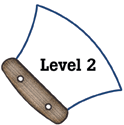
Alaska Science
Key Element D1
A student who meets the content standard should apply scientific knowledge and skills to understand issues and everyday events.
 |
Alaska Science A student who meets the content standard should apply scientific knowledge and skills to understand issues and everyday events. |
|
Performance Standard Level 2, Ages 8–10
|
|
|
|
Sample Assessment Ideas
|
|
|
Expanded Sample Assessment Idea
|
|
Procedure Students will:
Reflection and Revision
|
Levels of Performance |
||
|
Stage 4 |
Student work is complete, correct, and contains evidence of elaboration, extension, higher order thinking skills, and relevant knowledge. Student actively participates with group to perform an accurate and reliable test of the snowshoes and uses the results of the test to support the decision about which snowshoe works best. | ||
|
Stage 3
|
Student work is generally complete and correct but may contain evidence of some inaccuracies or omissions. Student participates with group to perform a test of the snowshoes though the test may be inaccurate or unreliable. Student decision about which snowshoe works the best is based on limited evidence from the test or on non-test related evidence. | ||
|
Stage 2
|
Student work may be incomplete or inaccurate. Student may be a reluctant group participant. The snowshoe test is inaccurate and unreliable. Student decision about which snowshoe works the best is not supported. | ||
|
Stage 1
|
Student work is incomplete and inaccurate. Student does not participate in group task or participate in a relay race or snowshoe test. | ||
Standards Cross-References
|
||
|
National Science Education Standards Use data to construct a reasonable explanation. This aspect of the standard emphasizes the students’ thinking as they use data to formulate explanations. Even at the earliest grade levels, students should learn what constitutes evidence and judge the merits or strengths of the data and information that will be used to make explanations. After students propose an explanation, they will appeal to the knowledge and evidence they obtained to support their explanations. Students should check their explanations against scientific knowledge, experiences, and observations of others. (Page 122) Develop descriptions, explanations, predictions, and models using evidence. Students should base their explanation on what they observed, and as they develop cognitive skills, they should be able to differentiate explanation from description—providing causes for effects and establishing relationships based on evidence and logical argument. This standard requires a subject matter knowledge base so the students can effectively conduct investigations, because developing explanations establishes connections between the content of science and the contexts within which students develop new knowledge. (Page 145) Scientific explanations emphasize evidence, have logically consistent arguments, and use scientific principles, models, and theories. The scientific community accepts and uses such explanations until displaced by better scientific ones. When such displacement occurs, science advances. (Page 148) |
Benchmarks Scientific investigations may take many different forms, including observing what things are like or what is happening somewhere, collecting specimens for analysis, and doing experiments. Investigations can focus on physical, biological, and social questions. (Page 11) Scientists’ explanations about what happens in the world come partly from what they observe, and partly from what they think. Sometimes scientists have different explanations for the same set of observations. That usually leads to their making more observations to resolve the differences. (Page 11) |
|
Table of Contents | Return to Alaska Native Knowledge Network